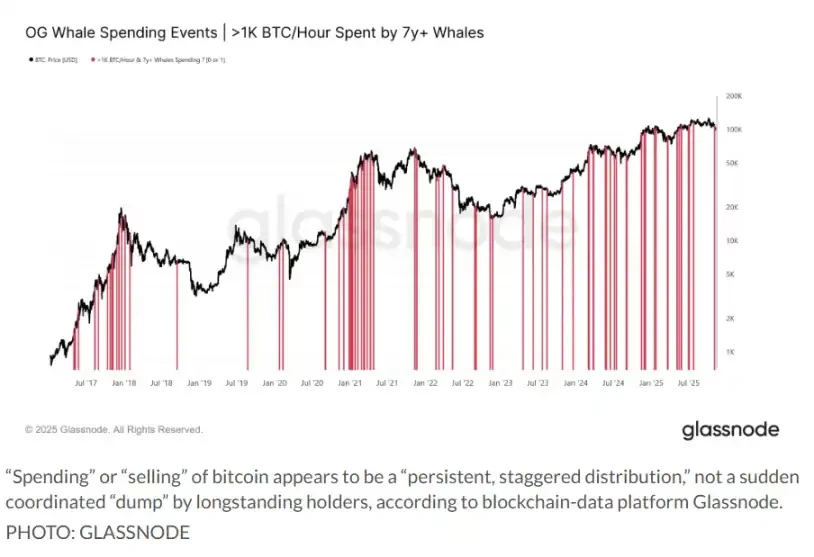"Whales" are accelerating their sell-off of Bitcoin, but this still doesn't qualify as a panic signal?
Original title: "Whales Accelerate Bitcoin Selling, But Still Not a Panic Signal?"
Original source: Jinshi Data
Bitcoin fell below the key $100,000 mark last week, with recent selling by "whales" (investors holding large amounts of cryptocurrency) and other long-term holders being a significant driver of the recent price weakness.
Most blockchain analytics firms define a "whale" as an individual or entity holding 1,000 or more bitcoins. While the identities of most "whales" remain unknown, blockchain data can still provide clues about their activities by tracking their cryptocurrency wallets.
Data shows that some "whales" have recently accelerated their Bitcoin selling. Some analysts say this phenomenon is noteworthy, but not necessarily a sign of panic. They point out that the recent selling may reflect steady profit-taking rather than panic selling, a pattern consistent with previous bull market cycles.
Martin Leinweber, head of digital asset research and strategy at MarketVector Indexes, said such sell-offs may reflect a “planned asset allocation.” “Some Bitcoin investors bought in when the price was in the single digits and have waited this long. Now there’s finally enough liquidity to sell without completely disrupting the market,” he told MarketWatch.
Despite recent complaints from cryptocurrency bulls about a lack of market liquidity, the ease of buying and selling Bitcoin has improved significantly compared to a decade ago.
However, analysts at blockchain analytics firm CryptoQuant say the recent sell-off by "whales" is worrying, coinciding with deteriorating market sentiment and a slowdown in buying, which could put further pressure on Bitcoin's price. Dow Jones market data shows that the largest cryptocurrency briefly approached $19,400 on Friday, its lowest level since May 6.
Comparison between the past and present
The sell-off of Bitcoin by long-term and large holders is not unique to the current cycle. Analysts at blockchain data platform Glassnode wrote in a recent report that there are signs that the recent sell-off is driven by profit-taking rather than panic.
Specifically, "whale" wallets that have held Bitcoin for more than seven years and sell more than 1,000 Bitcoins per hour exhibit a regular and steady selling behavior over a period of time (see the chart below, data as of last Thursday, November 13).

The selling behavior of "whales" exhibited a regular and uniform pattern over a period of time.
The significance of the $100,000 mark
Meanwhile, Cory Klippsten, CEO of Swan Bitcoin, a financial services company focused on Bitcoin, and a long-term Bitcoin investor, said that the massive sell-off by “whales” over the past few months appears to be related to the $100,000 mark for Bitcoin—a level that many early adopters have long regarded as a psychological threshold for taking profits.
“Since entering this space in 2017, many early holders I’ve met have talked about the $100,000 figure,” Kripsten told MarketWatch. “For some reason, people always say they’ll sell some of their holdings at that price.”
Glassnode data shows that since Bitcoin first broke $100,000 in December 2024, selling by long-term holders has intensified.
Potential alarm signals
However, CryptoQuant analysts wrote in a recent report that one changing factor is the market's ability to absorb sell-offs. While long-term holders sold off Bitcoin at the end of last year and the beginning of this year, other buyers stepped in to support the price, but this situation appears to have shifted.
Investment product fund flows can reflect weak demand – Dow Jones market data shows that as of last Thursday, Bitcoin exchange-traded funds (ETFs) saw outflows of $311.3 million for the week, on track for the fifth consecutive week of outflows, the longest consecutive outflow period since the week ending March 14 (when there were five consecutive weeks of outflows).
Over the past five weeks, Bitcoin ETFs have seen a cumulative outflow of $2.6 billion, the largest five-week outflow since the week ending March 28 (when $3.3 billion flowed out).
Recent price movements have brought the $100,000 mark back into focus. As of press time, Bitcoin is still trading below this level. Some technical analysts suggest that the market's failure to recover this key level could trigger further profit-taking.
To make matters worse, the overall macroeconomic environment is not favorable for risk assets. Joel Kruger, market strategist at LMAX Group, which operates a foreign exchange and cryptocurrency exchange, pointed out that this led to the liquidation of some long positions. "We believe that the market entered the fourth quarter with overly high expectations, stemming from seasonal trend analysis—historically, this period has performed exceptionally well," Kruger wrote in a letter to MarketWatch.
Krueger points out that risk assets, including Bitcoin, are under renewed pressure as investors lower their expectations for a December rate cut by the Federal Reserve and weak labor market data fuels economic concerns.
Sellers are still increasing their holdings.
Nevertheless, one of the largest known Bitcoin "whales" continues to buy.
Michael Saylor, chairman of software company Strategy Inc. (now widely regarded as a leveraged Bitcoin investment), said on CNBC last Friday that the company has been "accelerating" its Bitcoin purchases and will announce the details of its purchases on Monday morning.
As of last Friday, Strategy held over 640,000 bitcoins, representing more than 3% of the cryptocurrency's current circulating supply of 19.9 million. A Strategy representative did not immediately respond to emails seeking comment.
- 核心观点:巨鲸抛售比特币非恐慌信号。
- 关键要素:
- 抛售呈现规律匀速获利了结特征。
- 10万美元为早期持有者心理止盈位。
- 比特币ETF连续五周资金净流出。
- 市场影响:短期加剧价格波动压力。
- 时效性标注:短期影响



